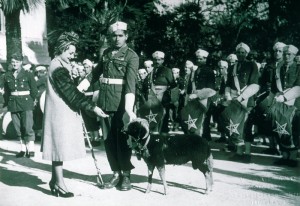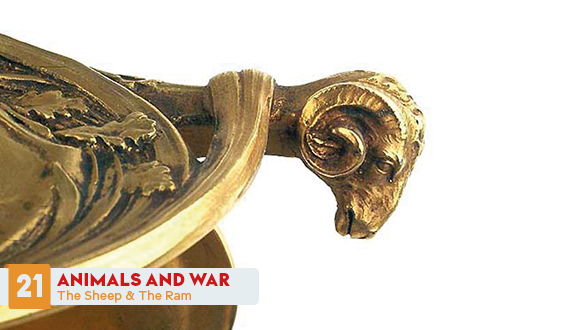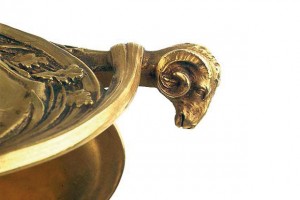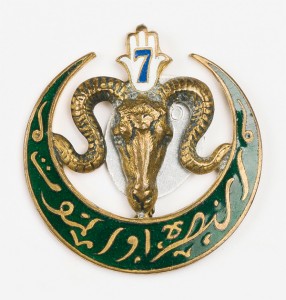
The movie actress Lucienne Galopaud, godmother of the wintering center of the Côte d’Azur, circa 1944-1945. © Paris, musée de l’Armée, dist. RMN-GP / Émilie Cambier
Sword of honor offered by the city of Paris to Marshal Joffre (1852-1931) by Henri Eugène Nocq (1868-1944). © Paris, musée de l’Armée Dist. RMN-GP / Pascal Segrette
Captain Gony’s Pelisse and Cap of 2nd Spahis. This pelisse dating from the Second Empire is in woolen cloth lined with astrakan. The astrakhan is a curly fur of karakul lamb (named after the village Karakul in Uzbekistan) stillborn, originally prepared in Astrakhan or according to the procedures used in that city. © Paris, musée de l’Armée, Dist. RMN-GP / Émilie Cambier
Badge of the 7th Regiment of Algerian Riflemen. © Paris, musée de l’Armée, Dist. RMN-GP / Émilie Cambier
The Sheep & The Ram
A weapon of war
Since the Antiquity, the ram left its name in poliorcetics as one of the most powerful war machine used in siege operations. The battering ram consisted of a large wooden beam with a head of iron used in breaching fortifications during a siege, a reference to the ovine characteristic of giving heavy repeated blows against its opponent.
Essential
Sheep represents one of the vital materials for making uniforms: wool. In the Programmes des cours révolutionnaires sur l’art militaire, l’administration militaire, la santé des troupes et les moyens de la conserver, printed by the French Revolutionalry Committee of Public Safety in 1794, it is stated: “A medium pack of fleece, after washing and spinning, produces about 2 pounds of wool. Assuming that a sheep gives 2 fleeces per year; 1,067,797 sheep would be needed in order to produce the 4,271,190 pounds of wool required.
During the French First Empire, the breeches worn by the Carabiniers-à-Cheval, cuirassiers and dragoons were made of deerskin or sheepskin. Sheepskin was also used for the harnessing and leather equipment in the Artillery and for the horses’ saddle blankets used in the Cavalry. During the Russian Campaign, the Napoleonic troops suffered from the cold, while the Russians, equipped with gloves, woollen stockings and sheepskin lined with wool were more resistant to low temperatures.
The Soldier’s plate
Soldiers were fed with ox meat and sheep. Sheep was used in the “ratatouille”, the famous Provençal stew combining meat and vegetable. During the Great War, the French soldier’s ration pack included a tin of boiled beef or corned beef nicknamed “monkey (meat) tin”. The army cooks also prepared dishes in sauce such as the mutton sauté.
In 1935, during the Second Italo-Abyssinian War, Italian units stationed in the Danakil Desert were supplied with lamb as planes dropped off ammunition, food and live sheep via parachutes.





Ajouter un commentaire